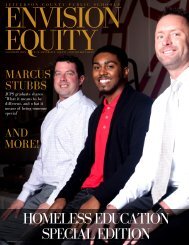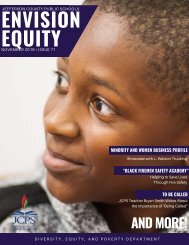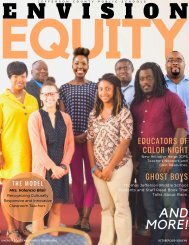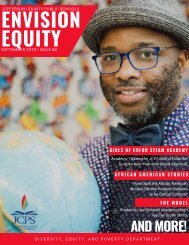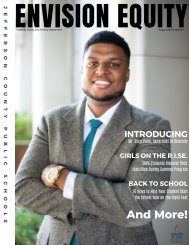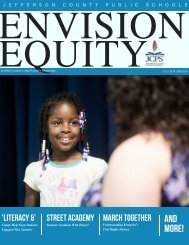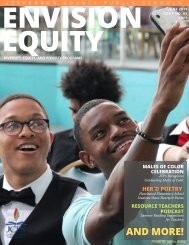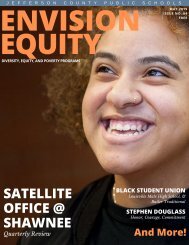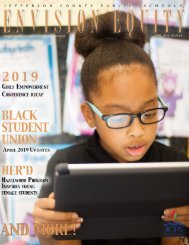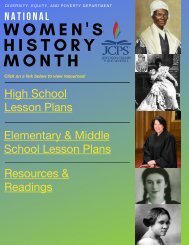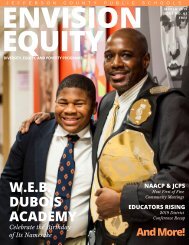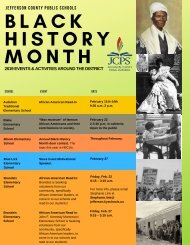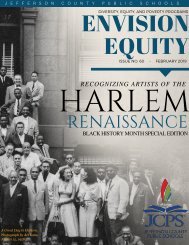2018 Black History Month Edition
Readers, Please enjoy the Black History Edition of our Envision Equity newsletter. This edition celebrates and recognizes black woman that have shaped and molded our world into a better place. As a reader, you will have access to photos from events that embody the purpose of this newsletter. We hope you enjoy, share, and contribute to the newsletter. Lastly, remember to Envision Equity.
Readers,
Please enjoy the Black History Edition of our Envision Equity newsletter. This edition celebrates and recognizes black woman that have shaped and molded our world into a better place.
As a reader, you will have access to photos from events that embody the purpose of this newsletter.
We hope you enjoy, share, and contribute to the newsletter. Lastly, remember to Envision Equity.
You also want an ePaper? Increase the reach of your titles
YUMPU automatically turns print PDFs into web optimized ePapers that Google loves.
1<br />
Photo, Getty Images
ENVISION EQUITY FEBRUARY <strong>2018</strong><br />
I Am Honored to Be the First African-<br />
American Chairwoman of Jefferson<br />
County Board of Education<br />
By Diane Porter—Jefferson County Board of Education<br />
Above, Diane Porter offers words of encouragement to a graduate of the Poetry & Prose<br />
program at the Academy of Music Production, Education and Development (AMPED)<br />
I<br />
t is an honor to be elected by my colleagues<br />
to be the first African-American chairwoman<br />
of Jefferson County Board of Education (JCBE).<br />
I cannot and will not take acclaim for this<br />
accomplishment without recognizing the<br />
greatness of so many African-American women<br />
who were, are, and will be influential to the<br />
progress of America and to public education. I<br />
would be foolish to believe that I got here on<br />
my own. I would like to thank the African-<br />
American women who served on this Board<br />
before me—Dr. Joyce Howell and Mrs. Ann<br />
Elmore. They made my service to education<br />
possible. I will not ignore the mighty past of<br />
African-American women. Harriet Tubman told<br />
us it's time to go. Sojourner Truth told us we<br />
can do anything a man can do. Their messages<br />
and their heroism still have validity today.<br />
It is time to move past the way we do certain<br />
things. It is time for my colleagues, allies, and<br />
me to move more of the masses across the<br />
Bios obtained from www.Biography.com<br />
2
achievement line and into a zone of educational freedom, one that allows students and families<br />
to thrive, not survive. I do not pretend that this position is anything close to what Harriet was<br />
put on this earth to do. However, I recognize that this position is set to make change and be a<br />
part of leading<br />
that requires<br />
knowledge,<br />
bravery, and<br />
the ability to<br />
challenge.<br />
Were it not for<br />
Harriet and<br />
many others<br />
demanding<br />
change, I may<br />
not be here. In<br />
short, many<br />
are counting<br />
on Jefferson<br />
Above, Diane Porter visits the AMPED program.<br />
County Public Schools (JCPS) not to maintain, but to move forward.<br />
What does moving forward look like? The answer is simple. All students get what they need in<br />
Above, Diane Porter, poses with students and faculty at King Elementary School<br />
during the closing ceremony at the Literacy & Photography program.<br />
order to succeed. All staff, certified<br />
and classified, get what they need<br />
so that they can help students<br />
become successful.<br />
Mary McCleod Bethune said,<br />
"Invest in the human soul. Who<br />
knows, it might be a diamond in<br />
the rough.” Ms. Bethune was a<br />
philanthropist and civil rights<br />
activist, noted for starting a private<br />
school for African Americans that<br />
later continued to develop as<br />
Bethune-Cookman University. Her dedication to education and her willingness to challenge and<br />
demand change reached my own family. My daughter graduated from this university, as have<br />
many others. The vision of the university was our children must never lose their zeal for
Above, Diane Porter, the first African-American chairwoman of the Jefferson<br />
County Board of Education (JCBE), congratulates a student during the closing<br />
ceremony at the Literacy & Chess program at Wheatley Elementary School.<br />
building a better world<br />
—“enter to learn, depart to<br />
serve.” Thus, Mary, Harriet,<br />
and Sojourner sit<br />
alongside me as I take this<br />
chair appointment. Their<br />
lasting impact is still as<br />
vibrant and ongoing as<br />
ever before.<br />
As I move forward,<br />
standing on the shoulders<br />
of my ancestors, I<br />
appreciate this<br />
opportunity to publish in<br />
the JCPS Envision Equity<br />
special edition during the<br />
month of February. Not just because it is African-American <strong>History</strong> <strong>Month</strong>, but also because we are<br />
celebrating the contributions of African-American women throughout history who have given us<br />
strength and continue to serve as beacons to guide us. Very seldom does a trail worth traveling<br />
come without resistance and doubters. None of us can afford to stop because of turbulence.<br />
It is my intention that we move forward with focus, fearlessness, and fortitude. To do anything less<br />
would be a failure to the future that we influence with everything we do or do not do.<br />
I am honored to be the first African-American chairwoman of the JCBE. I am focused to lead as so<br />
many African-American women before me have—with grit, love, pride, and purpose. I end with<br />
another quote from Mary McCloud Bethune, “I leave you hope ... I leave you a thirst for<br />
education ... I leave you racial dignity ... I leave you, finally, a responsibility to our young people.”<br />
All children can learn. All children do learn. It is all about what and how we teach them. I will do<br />
my part to make sure what they learn continues on the trail that so many have blazed for me.
ENVISION EQUITY FEBRUARY <strong>2018</strong><br />
Inspire—<br />
To Fill Someone With the Urge or Ability to Do Something<br />
By Angela Berry Allen—Principal, Olmsted Academy South<br />
Principal Angela Allene.<br />
I have always debated whether the<br />
coldest, grayest winter months were<br />
most appropriate months to celebrate<br />
and honor the many significant<br />
individuals and cultural groups who<br />
shaped our great country and inspired<br />
each of us to do great things for<br />
humanity. After all, who can celebrate<br />
and sincerely give thanks with all the<br />
ice, snow, cold, flu, holiday weight<br />
gain, rumors of nuclear war, fake news,<br />
and the list goes on. Honestly, the<br />
bears have this thing figured out,<br />
hibernate at<br />
the first sign<br />
of winter<br />
and stay put<br />
until spring<br />
—providing<br />
new<br />
inspiration<br />
with all her<br />
warmth,<br />
beauty, and<br />
new life—<br />
signals a<br />
new start.<br />
Alas, time<br />
waits for no woman and when tasked<br />
with writing about the great women<br />
who inspire me, I, like most,<br />
immediately thought about the great<br />
women in my personal life. A brave,<br />
loving, hardworking mother; a kind,<br />
loving, funny grandmother; three<br />
fiercely independent, brave aunts; two<br />
sisters and their beautiful, intelligent,<br />
and extremely talented daughters.<br />
Without a doubt, these women are<br />
precious to me and continue to shape
ENVISION EQUITY FEBRUARY <strong>2018</strong><br />
my<br />
world<br />
daily<br />
with<br />
new life<br />
lessons<br />
and<br />
encouragement to remain strong in my<br />
convictions and commitments. Then,<br />
naturally, I thought of all the great<br />
women of history and the present who<br />
blazed the path and made dreams<br />
possible for us all. I am grateful to<br />
Harriett Tubman, Sojourner Truth,<br />
Mahalia Jackson, Angela Davis, Betty<br />
Shabazz, Barbara Jordan, Maya<br />
Angelou, Coretta Scott King, Georgia<br />
Davis Powers, Maxine Waters, Aretha<br />
Franklin, Chaka Khan, Oprah, and Misty<br />
Copeland, who reminded us all that<br />
with extreme will and a willingness to<br />
work, we<br />
can<br />
accomplish<br />
much.<br />
However,<br />
there is<br />
another<br />
group of<br />
women in<br />
my sphere<br />
of<br />
Above, Olmsted Academy South students pose with<br />
their certificates at the closing of the G.I.R.L.S. On<br />
The Rise program.<br />
influence who stimulate my thinking,<br />
motivate me to want to do great things<br />
for myself and others, encourage me<br />
during those long days and late nights<br />
at my desk, energize me, and remind<br />
me of why I must get to school each<br />
day. They range in ages from 11 to 13<br />
and represent many cultural groups<br />
and ethnic hues, and they have the<br />
unlimited power to excite me and<br />
make me believe that with hard work<br />
and dedication to the task, we can<br />
make the world a better future place<br />
with no opportunity gaps! They inspire<br />
me because despite the rhetoric that<br />
suggests so many of them are<br />
disengaged from what matters in life,<br />
disinterested in academics and the role<br />
academics play in their futures, and are<br />
interested only in the newest cellphone<br />
or sneaker—these students continue to<br />
show up each day. They show up,<br />
holding out hope that today will be the<br />
day that they get the answers to the<br />
deep<br />
issues<br />
that<br />
plague<br />
them in<br />
their<br />
home<br />
lives and<br />
the<br />
promises<br />
that<br />
there will<br />
be safety and a future for them. They<br />
show up hoping that they will find at<br />
least one adult who will listen and not
ENVISION EQUITY FEBRUARY <strong>2018</strong><br />
judge. Last, but certainly not the only<br />
and least, they hope to finally find an<br />
access point that allows them to share<br />
in the wealth of classroom learning and<br />
not just sitting on the sidelines while<br />
learning happens around them. Never<br />
wanting to give the impression that I<br />
am clairvoyant, I surveyed a small<br />
group (ten or so) sixth, seventh, and<br />
eighth graders assigned to Saturday<br />
School. Now immediately some might<br />
think that this group, who had<br />
apparently, had a bump in the road<br />
would not be the optimal group to<br />
survey. However, I must confess an<br />
affinity for this group. They are the<br />
group who are taking slightly longer to<br />
figure it all out! I love them the most<br />
because if they had it all and knew it all,<br />
where would I find gainful<br />
employment?<br />
When asked what concerned,<br />
challenged, bothered them, the<br />
answers said much about how engaged<br />
they were! Answers included: My<br />
household financial abilities. How to<br />
make money at my age. Will I get a<br />
scholarship for college? How can I get<br />
good grades? What good jobs are going<br />
to pay so that I can provide for my<br />
family? Making sure that older kids who<br />
babysit have a cell phone at all times<br />
and don’t open the door even when<br />
parents knock because they have a key.<br />
Wondering what kind of day I’m going to<br />
have because anything could go wrong<br />
at any time. About my family when they<br />
are having a bad day. The list went on.<br />
When asked what school could do to<br />
make it better, they said: Focus a tiny bit<br />
more on our dreams and what we want<br />
to do. Have more go-to people like Ms.<br />
******. She is the one person that I think I<br />
could tell anything to and she not look at<br />
me any differently. Be more<br />
understanding because they don’t know<br />
what students go through when they get<br />
home. They could have a group of people<br />
that come from big jobs to explain how<br />
they got where they are. I want them<br />
[teachers] to help make me want my<br />
dreams and help me through my rough<br />
times, and I want them to lift me up<br />
more.<br />
The verb inspire calls to action our<br />
abilities to encourage, influence, and<br />
motivate. Thanks to all who show up<br />
each day to inspire and be inspired. As<br />
Helen Keller said, “The best and most<br />
beautiful things in the world cannot be<br />
seen or even touched—they must be<br />
felt in the heart.”
ENVISION EQUITY FEBRUARY <strong>2018</strong><br />
The<br />
<strong>Black</strong> Female<br />
Experience in <strong>2018</strong><br />
By Timiah Croney—Central High School Student<br />
I find being a<br />
<strong>Black</strong>/African-<br />
American<br />
woman in the<br />
world today<br />
very<br />
challenging<br />
and difficult.<br />
Women still get<br />
treated<br />
differently than men, and<br />
discrimination based on skin color is<br />
still an issue in the world today. I<br />
believe these societal issues affect<br />
some <strong>Black</strong> women’s confidence levels,<br />
and they feel powerless to try to fight<br />
back to prove people wrong about<br />
their strength and greatness.<br />
hateful way. The media always focus<br />
on the negative and not the positive<br />
differences <strong>Black</strong> people and <strong>Black</strong><br />
women are making in the world.<br />
I realize that as a woman, it will be up<br />
to me to be strong and independent<br />
and to fight the negative stereotypes<br />
that exist about both <strong>Black</strong> people and<br />
women. While others may try to knock<br />
me down and silence me, I will use my<br />
education, my morals, and my faith in<br />
God to make the world a better place<br />
for all people.<br />
Sometimes I think, What is wrong with<br />
my skin color? But I never say I hate<br />
being <strong>Black</strong> because God made me<br />
who I am and I love myself. It bothers<br />
me that some <strong>Black</strong> people want to kill<br />
each other and act so horrible to make<br />
others call us all “the N-word” again<br />
and look at us in such a shameful or
ENVISION EQUITY FEBRUARY <strong>2018</strong><br />
<strong>Black</strong> Woman In America<br />
A Poem by Salem Gaines—Central High School Student<br />
What is it like to be a black woman living?<br />
To be in America<br />
To know and tell how you’re feeling<br />
But when you are heard<br />
Always the color of your skin seems to be taken into account<br />
Not complaining<br />
Just want to be heard out<br />
Often conforming to a rubric long ago created<br />
Often joining into old thought processes<br />
Cause so many others participated<br />
Pushing aside the fact that you are an individual<br />
Forgetting major differences are not only ethnic and visual<br />
Sometimes mistaking race for ethnicity<br />
Refusing to connect the present to history<br />
Making generalizations and expecting like behavior to come naturally<br />
Testing racial theories to test its reality<br />
Wondering what is easy and what is actually hard<br />
Is the game of life a game of chess or Cards?<br />
Are you pinning the plot of your circumstance to the way you look<br />
Do you consider your journey your personal journal or a hardback book?<br />
What is a challenge?<br />
Learning what makes you black and what does not<br />
Being content with the hair and expectations you’ve got<br />
What is to love and what is to hate<br />
My answer is the same for both its all debate
Who I Admire Most<br />
Influential Women of Color Share Their Most Influential or Admired<br />
African American Historical Figure<br />
-Dr. Tauetta Taul, Marion C. Moore<br />
School, Assistant Principal<br />
S<br />
ome may ask how we describe or<br />
characterize African-American<br />
women and/or women in general. It’s<br />
best expressed through the vibrant,<br />
poetic, and inspiring words of the<br />
great Maya Angelou, who said, “Strong<br />
Woman – You may encounter many<br />
defeats, but you must not be defeated.<br />
In fact, it may be necessary to<br />
encounter the defeats so you can<br />
know who you are, what you can rise<br />
from, how you can still come out of it.”<br />
African American women have in fact<br />
encountered many years of defeat,<br />
and yet we are still striving to be the<br />
best we can be, being recognized for<br />
our accomplishments, and given the opportunities to demonstrate our abilities. It’s<br />
imperative, and we would be remiss if we didn’t acknowledge the pioneers past and present<br />
who have made it possible, paved the way, and unapologetically provided a shoulder for us<br />
to stand on. As a middle-aged young African American woman, I believe we must continue<br />
in the spirit of our predecessors and help one another as well as the younger generation of<br />
women. This can be accomplished when we rally around one another and are willing to<br />
share our knowledge, resources, talents, and time. It’s important to deposit into our young<br />
women to allow them to be relentless enough to withdraw greatness from deeply rooted<br />
wells of perseverance and survival. We must be willing to share our defeats and strategies<br />
Continued on next page
for living a victorious life. Overall, I attribute my success to having an example of a strong<br />
woman in my mother and many other women who took the time to divulge to me the hidden<br />
secrets of life and this world. In addition to them, I found strength and inspiration through<br />
historical women who served as living examples of defeat and triumph.<br />
One African<br />
American woman<br />
in history who has<br />
made an<br />
impression upon<br />
me and<br />
influenced my<br />
service to society,<br />
as well as<br />
endeavors for<br />
educational<br />
equality, is Mary<br />
McLeod Bethune.<br />
Throughout<br />
history, the<br />
African American race has made many contributions to the overall success of this country.<br />
Moreover, various African American women have regrettably been disregarded for their<br />
influence and demonstration of being a strong woman. Nonetheless, despite public<br />
adoration, there are those of us who recognize and acknowledge individual pioneers for their<br />
impact in our lives. Furthermore, if we aspire to be change agents who truly impact the lives<br />
of others, ideally we reminiscence over the moment that transformed our lives. For me, the<br />
moment occurred when I was asked to perform a yearly, routine, normal assignment. I recall<br />
being in middle school and completing my <strong>Black</strong> <strong>History</strong> <strong>Month</strong> report. I remember thinking<br />
that I wanted to learn of someone different from the familiar historic figures so frequently<br />
suggested to us. After consulting with a retired African American teacher, I was directed to Dr.<br />
McLeod Bethune. Upon learning about her struggles and accomplishments, I was astonished.
At such a young age, I wasn’t aware of how she would later impact my passion for fulfilling<br />
my life’s purpose and that I would later walk in her shoes of educating our youth. Once I<br />
realized in my sophomore year in college that a law degree was not satisfying my desire to<br />
continue on in education, I ignited my<br />
faith, changed my major to secondary<br />
social studies education, and redirected<br />
the trajectory of my life. Subsequently, Dr.<br />
McLeod Bethune is one of the pioneers<br />
whom I immediately retreated. I wanted to<br />
impact the lives of youth as she did<br />
regardless of the barriers that may have<br />
been encountered. I too desired to open<br />
my own school and/or community center,<br />
lead a school, or at least play an<br />
instrumental role in the lives of students<br />
and other colleagues who encounter<br />
students daily. My goal was to obtain as<br />
much education as possible and to commit<br />
to being a lifelong learner. With faith and<br />
passion as demonstrated through her<br />
achievements, I have been presented the<br />
opportunity to impact the lives of students<br />
and educators. Dr. McLeod Bethune was<br />
faithful, persistent, generous, and devoted<br />
to her service to others her entire life. I continue to strive to have that testimony.<br />
Although I have been a classroom teacher and am currently an administrator and adjunct<br />
professor, my service is still not complete. I desire to continue on for our disadvantaged<br />
youth and to impart in them the same passion, hope, and encouragement that was<br />
afforded me several years ago. As we celebrate women and African American <strong>History</strong><br />
<strong>Month</strong>, I implore all women to take some time to encourage another woman and be<br />
willing to offer guidance if needed. We must embody Maya Angelou’s words when she<br />
expressed, “I would like to be known as an intelligent woman, a courageous woman, a<br />
loving woman, a woman who teaches by being.”
-Shashray McCormack, Teacher Mill<br />
Creek Elementary School<br />
“<br />
In order for us as poor and oppressed people to<br />
become part of a society that is meaningful, the system<br />
under which we now exist has to be radically changed ... It<br />
means facing a system that does not lend itself to your<br />
needs and devising means by which you change that<br />
system.”<br />
—Ella Baker, Organizer and Activist<br />
As I think about Ella Baker’s advocating for civil rights and social justice, I see how she has<br />
influenced me to invest in young people and advocating for students to learn about their<br />
history. She loved people and wanted the voice of the youth to be heard. Baker led quietly<br />
by example; she inspired, guided and invested in young people. It is important to be a part<br />
of those who are growing, and for me, that<br />
would be the students of Jefferson County<br />
Public Schools (JCPS). The organizational<br />
philosophies Baker brought to the Student<br />
Nonviolent Coordinating Committee<br />
(SNCC), along with her leadership skills,<br />
helped encourage young people to look to<br />
themselves as the main catalyst for change.<br />
A catalyst to change inequities relating to education, economics, history, race, culture,<br />
gender, and politics. Her philosophies help me ensure a quality public education for all<br />
students. Giving voice to students to speak their truth and recognize they are bold,<br />
confident, kind, and brilliant! Her leadership did not look like the leadership of the time.<br />
The look of her leadership influenced collective decision making with students, not for<br />
students. My students and I grow and learn together. We want to radically change what<br />
education looks like. Education has looked the same for many years; we want to organize<br />
differently, lead differently. We organize differently starting with curriculum and we lead<br />
differently by giving students voice to think critically about what they are being taught.
-Stephanie White, Principal,<br />
King Elementary School<br />
n African-American<br />
figure who has influenced<br />
me is Oprah Winfrey. What I<br />
admire most is her drive to<br />
empower people, especially<br />
women and young girls.<br />
Over the years, Ms. Winfrey<br />
has helped others find their<br />
voice, experience their best<br />
life, and reflect on those<br />
experiences to make new<br />
decisions about who they<br />
want to be. A driving force<br />
in my life is to empower<br />
others and help our families<br />
navigate resources to make<br />
choices that best support<br />
their upward mobility. The<br />
one thing we all have in<br />
common is the ability to make<br />
choices; regardless of the choices we make, the power comes when we make the choice to<br />
choose again.<br />
A
-Ashley M. Parrott<br />
Senior Policy and Development Advisor<br />
Office of Mayor Fischer<br />
Louisville Metro Government<br />
chose President Barack Obama as my<br />
favorite historical figure because he<br />
inspired me to remain dedicated to my passion<br />
for public service. His presidency spoke to the<br />
hearts, minds and souls of our youngest and<br />
oldest generations. I am incredibly grateful<br />
that we had the opportunity to elect and experience the outstanding leadership of<br />
our first black President.<br />
I<br />
-Veronda Hawkins<br />
Secretary to Dr. John D. Marshall,<br />
JCPS Chief Equity Officer<br />
I<br />
am most influenced by Michelle Obama because of<br />
her integrity, compassion and vision that she brought<br />
to the White House. She graced the White House with<br />
such wisdom, knowledge and beauty. I was inspired by<br />
her relentless efforts to change what our children are<br />
eating at school. She put energy into planting and<br />
growing food at the White House and inviting students to<br />
come and learn about different foods and visiting schools<br />
to get the message out about healthy eating. I believe that she is such a role model for<br />
our black girls and women to be inspired to do positive things in our communities, to<br />
believe in positive change and have compassion for others.
-Dr. Monica Lakhwani, Specialist, JCPS Diversity,<br />
Equity, and Poverty Programs<br />
ose Mapendo, Congolese American, who survived<br />
genocide and prison camp inspires me. Founder<br />
of the Rose Mapendo<br />
Foundation, she serves<br />
as an advocate for<br />
refugees and empowers<br />
women especially girls. I<br />
had the honor of<br />
meeting her in 2015 and her strength, courage, and humility<br />
remain with me.<br />
R<br />
Today Rose works as a global activist to bring awareness to<br />
the violence that continues in theDemocratic Republic of Congo. Residing in Phoenix,<br />
Arizona, she is living proof that it is possible for a Tutsi woman to live a happy and healthy<br />
life that is full of worth and value – something that once seemed impossible. Through the<br />
Rose Mapendo Foundation, she is able to provide necessary survival resources to women in<br />
the DRC who continue to be affected by thevicious ethnic warfare that still exists. The<br />
ultimate goal for Rose and the foundation is to end suffering for all women by securing for<br />
them a spot at the peace table where true change can be made.<br />
-Giselle Danger-Meraderes, Coordinator<br />
Student Equity and Community Engagement<br />
D<br />
r. King continues to inspired many Latinos today<br />
including me. I believe that If he were alive today, he likely<br />
would be working side by side with Latinos and other<br />
minority groups to address the issues of inequality we<br />
continue to face today.
-Dr. Donna Y. Ford, Professor of Education and<br />
Human Development at Vanderbilt University<br />
T<br />
here are several African Americans who have<br />
influenced my life in a number of ways – academically,<br />
philosophically, socially, mentally, and politically. When<br />
I merge these ways, one <strong>Black</strong> female rises to the top<br />
and she is former First Lady Michelle Obama. All that<br />
she does and epitomizes resonates with me as a <strong>Black</strong><br />
female committed to equity. Former FLOTUS is brilliant,<br />
equity-minded, and a dedicated mother and<br />
spouse. Michelle Obama is humane and real, with an<br />
admirable ability to connect to with people – those<br />
facing all types of challenges. Even when under<br />
attack, Michelle Obama took the high road. I will always<br />
remember “when they go low, we go high.”<br />
I respect her focus on family, education, and health. She<br />
is authentic, and such a role model. The links below<br />
say more.
Diversity, Equity, and Poverty Programs Celebrates <strong>Black</strong> <strong>History</strong><br />
Alberta Jones<br />
1930-1965<br />
Alberta Odell Jones was born in Louisville, KY, the third child of Sarah<br />
(Sadie) Frances Crawford Jones and Odell Jones. She was also a<br />
first cousin of Raymond Ponder. During her brief life, Alberta<br />
Jones was at the forefront of change in Kentucky and<br />
Louisville. She was one of the first African American<br />
women to pass the Kentucky Bar (1959) and the first<br />
woman prosecutor in Kentucky (1964). [Sally J. Seals<br />
White was the first African American woman admitted<br />
to the Kentucky Bar.]<br />
Jones was prosecutor in the Louisville Domestic<br />
Relations Court; her law office was located at <strong>2018</strong> W.<br />
Broadway. [James A. Crumlin, Sr. was the assistant<br />
prosecutor.] Jones was Cassius Clay's [Muhammad Ali's]<br />
first attorney, taking him to California to be trained<br />
under Archie Moore. Jones was also a civil rights<br />
activist: in addition to participating in the March on<br />
Washington and the marches in Louisville, she<br />
rented voting machines and held classes to teach<br />
African Americans how to vote for the candidates of<br />
their choice. Jones also established the James<br />
"Bulky" Welch Fund and held a fund-raiser, raffling<br />
off a car to pay Welch's medical bills and purchase the prosthetic arms to replace the<br />
ones young Welch had lost trying to retrieve his dog from under a train. Alberta Jones<br />
was a graduate of Louisville Central High School and attended the Louisville Municipal<br />
College for Negroes. When the college was merged with the University of Louisville (U of<br />
L) during desegregation, Jones continued her education at U of L and graduated third in<br />
her class. A picture of Alberta O. Jones hangs in theU of L Law School. She was a<br />
member of the American Bar Association, the Fall City Bar Association, and the Louisville<br />
Bar Association, serving as secretary of the latter. She was also a member of the Eta Zeta<br />
Chapter of Zeta Phi Beta and the Sigma Chapter of Iota Phi Lambda. Alberta O. Jones<br />
was murdered in August of 1965 -- the case has not been solved.<br />
Bios obtained from www.Biography.com
Diversity, Equity, and Poverty Programs Celebrates <strong>Black</strong> <strong>History</strong><br />
Georgia D. Powers<br />
1923-2016<br />
Georgia Davis Powers was an American politician, who<br />
served for 21 years as a member of the state<br />
senate in the Commonwealth of Kentucky.<br />
In 1967, she was the first person of color<br />
and the first woman elected to the<br />
senate.<br />
Elected to serve in the Kentucky Senate<br />
from January 1968 to January 1989,<br />
Powers sponsored bills prohibiting<br />
employment discrimination, sex and age<br />
discrimination, in addition to introducing<br />
statewide fair housing legislation. She was a<br />
leader in the movement to change what many<br />
considered the racially insensitive wording of the<br />
Kentucky State Song, My Old Kentucky Home,<br />
in 1986.<br />
Powers was included in a national<br />
photographic exhibit that opened on<br />
February 8, 1989, at the Corcoran<br />
Gallery in Washington, D.C.: Portraits of<br />
<strong>Black</strong> Women Who Changed America.<br />
In 1989 Powers received an honorary<br />
doctor of laws degree from the<br />
University of Kentucky and an<br />
honorary doctorate of humane letters<br />
from the University of Louisville.<br />
19
Diversity, Equity, and Poverty Programs Celebrates <strong>Black</strong> <strong>History</strong><br />
Alexa Canady<br />
1950-<br />
Dr. Alexa Canady was born on November 7, 1950, in Lansing,<br />
Michigan. While she was in college, a summer program<br />
inspired her to pursue a medical career. In 1981, she<br />
became the first female African-American neurosurgeon<br />
in the United States. Canady specialized as a pediatric<br />
neurosurgeon and served as chief of neurosurgery at the<br />
Children's Hospital in Michigan from 1987 to 2001.<br />
While Alexa Canady was attending the University of<br />
Michigan, a health careers summer program for minority<br />
students sparked her interest in medicine. After<br />
graduating from college in 1971 with a major in<br />
zoology, Canady continued on to the<br />
university's medical school.<br />
Canady initially wanted to be an internist,<br />
but her plans changed when she became<br />
intrigued by neurosurgery. It was a career<br />
path that some advisers discouraged her<br />
from pursuing, and she encountered<br />
difficulties in obtaining an internship. But<br />
Canady refused to give up, and was<br />
eventually accepted as a surgical intern at Yale-New Haven Hospital. She went there<br />
after graduating, cum laude, from medical school in 1975.<br />
When her internship ended in 1976, Canady moved to the University of Minnesota,<br />
becoming, as a resident of the university's department of neurosurgery, the first female<br />
African-American neurosurgery resident in the United States. Upon completing her<br />
residency in 1981, she became the country's first female African-American<br />
neurosurgeon.<br />
20
Diversity, Equity, and Poverty Programs Celebrates <strong>Black</strong> <strong>History</strong><br />
Mae Street Kidd<br />
1904-1999<br />
Businesswoman, politician, and civil rights activist,<br />
Mae Street Kidd, was born February 8, 1904 in<br />
Millersburg, Kentucky to a black mother and<br />
white father. Kidd’s biological father<br />
refused to acknowledge her as his<br />
daughter. She attended a segregated<br />
black primary school in her community.<br />
As a teenager, Kidd enrolled at Lincoln<br />
Institute in Simpsonville, Kentucky, a<br />
boarding school for African Americans.<br />
After completing school, Kidd moved to<br />
Louisville. She became a successful life<br />
insurance agent at the black owned Mammoth<br />
Life Insurance Company. During World War II,<br />
Kidd served with the American Red Cross in<br />
England. Following the war, she became an<br />
entrepreneur, opening a cosmetic and an<br />
insurance company in the Midwest.<br />
She served in the Kentucky House of<br />
Representatives from 1968 to 1984,<br />
representing Louisville’s 41st legislative<br />
district. Kidd co-sponsored legislation to<br />
make Dr. Martin Luther King Jr.’s birthday a<br />
state holiday and the Kentucky Fair Housing Act of 1968, which provided accessible and<br />
low-income housing to all Commonwealth residents. In the 1970s, Kidd continued her<br />
housing advocacy efforts, and following a two year battle on the House floor, she<br />
introduced House Bill No. 27 to the House, and it became law in 1972. The law<br />
established the Kentucky Housing Corporation, which promoted and financed lowincome<br />
housing.<br />
21
Diversity, Equity, and Poverty Programs Celebrates <strong>Black</strong> <strong>History</strong><br />
Simone Askew<br />
1997-<br />
Simone Askew is the first African-American woman to hold the position of First Captain<br />
of the U.S. Military Academy's Corps of Cadets, Askew is responsible for overseeing the<br />
performance of approximately 4,400 students.<br />
As a 6-year-old child camping in the Virginia<br />
woods, Simone Askew marched for fun,<br />
wielding a plastic gun and leading her<br />
young sister and friends in formation.<br />
A few years later, the sight of Navy<br />
midshipmen striding across an<br />
Annapolis football field solidified her<br />
desire to be the person who led troops.<br />
The first captain position is often a herald of<br />
successful Army careers. Cadet Vincent K.<br />
Brooks held the title in 1980, becoming the first<br />
African-American to serve as West Point first<br />
captain — and he now is a four-star general<br />
commanding American forces in South Korea. Cadet<br />
John W. Nicholson Jr. was first captain in 1982, and he<br />
also wears four stars today as the senior American<br />
and NATO commander in Afghanistan.<br />
The significance of Cadet Askew’s<br />
achievement has resonated<br />
with many black women who<br />
have graduated from West<br />
Point; most attended the<br />
school when a white male<br />
held the prestigious and<br />
competitive role.<br />
22
Diversity, Equity, and Poverty Programs Celebrates <strong>Black</strong> <strong>History</strong><br />
Ava DuVernay<br />
1972-<br />
Ava Marie DuVernay is an American film director, producer, screenwriter, film marketer,<br />
and film distributor. At the 2012 Sundance Film<br />
Festival, DuVernay won the Best Director Prize<br />
for her second feature film Middle of Nowhere,<br />
becoming the first African-American woman<br />
to win the award.<br />
For her work in Selma(2014), DuVernay was<br />
the first black female director to be<br />
nominated for a Golden Globe Award.<br />
With Selma, she was also the first<br />
black female director to have her<br />
film nominated for the Academy<br />
Award for Best Picture. In<br />
2017, she was nominated for<br />
the Academy Award for<br />
Best Documentary<br />
Feature for her film 13th<br />
(2016).<br />
DuVernay's next film, A<br />
Wrinkle in Time,<br />
reportedly has a<br />
budget exceeding $100<br />
million, making<br />
DuVernay the first black<br />
woman to direct a liveaction<br />
film with a budget<br />
of that size.<br />
23
Diversity, Equity, and Poverty Programs Celebrates <strong>Black</strong> <strong>History</strong><br />
Tia Norfleet<br />
1986<br />
As a second generation licensed NASCAR driver, Tia Norfleet is<br />
understand what it is to break barriers and she well knows the low<br />
odds and risks involved with being a professional racecar driver.<br />
Her father, Bobby Norfleet was a fairly prominent driver himself<br />
throughout the '90s, and is credited with helping the sport<br />
gain traction in the African-American community. He lists his<br />
three mentors as NASCAR champion Wendell Scott, Hall of<br />
Fame driver Alan Kulwicki and singer Gladys Knight, who<br />
told him: "Whatever I do for you, you better be willing to do<br />
it for somebody else." Taking that advice to heart, when his<br />
daughter began to take a keen interest in the sport, he in<br />
turn shifted his focus.<br />
This past June, 2011, Tia delivered the graduation<br />
commencement address to the Unidad of Miami Beach & the<br />
New Generation Leadership and Workforce Institute’s<br />
(NGLWI) graduating class. Tia is also involved with<br />
children and looks to help out in way that she can. This<br />
year, Tia plans to take her Driven to Read program to<br />
the next level, which teaches kids the importance of<br />
reading and its kinship to racing. It will be centered<br />
around her new comic book series that is being<br />
developed by the renowned Reginald Byers.<br />
24
Diversity, Equity, and Poverty Programs Celebrates <strong>Black</strong> <strong>History</strong><br />
Bessie Coleman<br />
Bessie Coleman was the first black woman to earn a pilot's license.<br />
Because flying schools in the United States denied her entry, she<br />
taught herself French and moved to France, earning her license<br />
from France's well-known Caudron Brother's School of<br />
Aviation in just seven months. Coleman specialized in<br />
stunt flying and parachuting, earning a living<br />
barnstorming and performing aerial tricks. She<br />
remains a pioneer of women in the field of<br />
aviation.<br />
In 1922, a time of both gender and racial<br />
discrimination, Coleman broke barriers<br />
and became the world's first black<br />
woman to earn a pilot's license.<br />
Because flying schools in the United<br />
States denied her entry, she took it<br />
upon herself to learn French and move<br />
to France to achieve her goal. After<br />
only seven months, Coleman earned<br />
her license from France's well known<br />
Caudron Brother's School of Aviation.<br />
Tragically, on April 30, 1926, Coleman<br />
was killed in an accident during a<br />
rehearsal for an aerial show which sent<br />
her plummeting to her death. She was only<br />
34 years old.<br />
Coleman remains a pioneer of women in the<br />
field of aviation.<br />
1892 - 1926<br />
25
Diversity, Equity, and Poverty Programs Celebrates <strong>Black</strong> <strong>History</strong><br />
Alice Coachman<br />
1923-2014<br />
Alice Coachman became the first African American woman from any<br />
country to win an Olympic Gold Medal when she competed at the 1948<br />
Summer Olympics in London, UK. Born November 9, 1923, in<br />
Albany, Georgia, to Evelyn and Fred Coachman, Alice was the<br />
fifth of ten children. As an athletic child of the Jim Crow South,<br />
who was denied access to regular training facilities,<br />
Coachman trained by running on dirt roads and creating her<br />
own hurdles to practice jumping.<br />
During World War II, the Olympic committee cancelled the<br />
1940 and 1944 games. Alice Coachman’s first Olympic<br />
opportunity came in 1948 in London, when she was twentyfour.<br />
On August 8, 1948, Alice Coachman leapt 5 feet 6 1/8<br />
inches to set a new Olympic record and win a gold medal<br />
for the high jump.<br />
During her career, she won thirty-four national<br />
titles, ten for the high jump in consecutive<br />
years. Alice Coachman was inducted into nine<br />
halls of fame including the National Track-and-<br />
Field Hall of Fame (1975) and the U.S. Olympic<br />
Hall of Fame (2004). Coachman became the<br />
first black woman to endorse an international<br />
product when Coca-Cola signed her as a spokesperson in<br />
1952. Coachman married Frank A. Davis and is the mother of two children. In 1994, she<br />
founded the Alice Coachman Track and Field Foundation to provide assistance to young<br />
athletes and former Olympic competitors.<br />
Coachman died in Albany, Georgia on July 14, 2014. She was 90.<br />
26
Diversity, Equity, and Poverty Programs Celebrates <strong>Black</strong> <strong>History</strong><br />
Toni Morrison<br />
Born on February 18, 1931, in Lorain, Ohio, Toni Morrison is a Nobel Prize- and Pulitzer<br />
Prize-winning novelist, editor and professor. Her novels are known for their epic themes,<br />
exquisite language and richly detailed African-American characters who are central to their<br />
narratives. Among her best known novels are The Bluest<br />
Eye, Sula, Song of Solomon, Beloved, Jazz, Love and A<br />
Mercy. Morrison has earned a plethora of book-world<br />
accolades and honorary degrees, also receiving the<br />
Presidential Medal of Freedom in 2012.<br />
Morrison's first novel, The Bluest Eye, was published<br />
in 1970. She used as her literary first name "Toni,"<br />
based on a nickname derived from St. Anthony after<br />
she'd joined the Catholic Church. The book follows a<br />
young African-American girl, Pecola Breedlove, who<br />
believes her incredibly difficult life would be better if<br />
only she had blue eyes. The controversial book<br />
didn't sell well, with Morrison stating in a 1994<br />
afterword that the reception to the work was<br />
parallel to how her main character was treated<br />
by the world: "dismissed, trivialized, misread."<br />
1931-<br />
A rising literary star, Morrison was appointed to<br />
the National Council on the Arts in 1980. The<br />
following year, Tar Baby was published. The<br />
Caribbean-based novel drew some inspiration from folktales and received a decidedly<br />
mixed reaction from critics. Her next work, however, proved to be one of her greatest<br />
masterpieces. Beloved (1987) explores love and the supernatural. Inspired by real-world<br />
figure Margaret Garner, main character Sethe, a former slave, is haunted by her decision to<br />
kill her children rather than see them become enslaved. Three of her children survived, but<br />
her infant daughter died at her hand. Yet Sethe's daughter returns as a living entity who<br />
becomes an unrelenting presence in her home. For this spellbinding work, Morrison won<br />
several literary awards, including the 1988 Pulitzer Prize for Fiction. Ten years later, the<br />
book was turned into a movie starring Oprah Winfrey, Thandie Newton and Danny Glover.<br />
27
Diversity, Equity, and Poverty Programs Celebrates <strong>Black</strong> <strong>History</strong><br />
Coretta Scott King<br />
1927–2006<br />
Coretta Scott was born on April 27, 1927, in Marion,<br />
Alabama. In the early decades of her life, Coretta was<br />
as well known for her singing and violin playing as<br />
her civil rights activism. She attended Lincoln High<br />
School, graduating as the school's valedictorian in<br />
1945, and then enrolled at Antioch College in<br />
Yellow Springs, Ohio, receiving her Bachelor of<br />
Arts in music and education in 1951.<br />
Coretta was awarded a fellowship to the New<br />
England Conservatory of Music in Boston,<br />
Massachusetts, where she met soon-to-be famed<br />
civil rights leader Martin Luther King Jr., then a<br />
doctoral candidate at Boston University’s School of<br />
Theology. They married on June 18, 1953, at her<br />
family home in Marion.<br />
After earning her degree in voice and violin<br />
from NEC in 1954, Coretta moved with her<br />
husband to Montgomery, Alabama, where<br />
he served as pastor of Dexter Avenue<br />
Baptist Church and she, subsequently, oversaw the various tasks of a pastor's wife.<br />
Working side by side with her husband throughout the 1950s and '60s, Coretta took part<br />
in the Montgomery Bus Boycott of 1955, journeyed to Ghana to mark that nation's<br />
independence in 1957, traveled to India on a pilgrimage in 1959 and worked to pass the<br />
1964 Civil Rights Act, among other endeavors.<br />
Though best known for working alongside her husband, Coretta established a<br />
distinguished career in activism in her own right. Among many roles, she worked as a<br />
public mediator and as a liaison to peace and justice organizations.<br />
28
Diversity, Equity, and Poverty Programs Celebrates <strong>Black</strong> <strong>History</strong><br />
Wilma Rudolph<br />
1940-1994<br />
Born on June 23, 1940, in St. Bethlehem, Tennessee, Wilma<br />
Rudolph was a sickly child who had to wear a brace<br />
on her left leg. She overcame her disabilities to<br />
compete in the 1956 Summer Olympic Games,<br />
and in 1960, she became the first American<br />
woman to win three gold medals in track and<br />
field at a single Olympics.<br />
Growing up in the segregated South,<br />
Rudolph attended the all-black Burt<br />
High School, where she played on the<br />
basketball team. A naturally gifted<br />
runner, she was soon recruited to train<br />
with Tennessee State University track coach Ed<br />
Temple.<br />
Nicknamed "Skeeter" for her famous speed, Wilma<br />
Rudolph qualified for the 1956 Summer Olympic Games in Melbourne, Australia. The<br />
youngest member of the U.S. track and field team at age 16, she won a bronze medal in<br />
the 400-meter relay. After finishing high school, Rudolph enrolled at Tennessee State<br />
University, where she studied education. She also trained hard for the next Olympics.<br />
the 1960 Olympic Games were a golden time for Rudolph. After tying a world record with<br />
her time of 11.3 seconds in the 100-meter semifinals, she won the event with her windaided<br />
mark of 11.0 seconds in the final. Similarly, Rudolph broke the Olympic record in<br />
the 200-meter dash (23.2 seconds) in the heats before claiming another gold medal with<br />
her time of 24.0 seconds. She was also part of the U.S. team that established the world<br />
record in the 400-meter relay (44.4 seconds) before going on to win gold with a time of<br />
44.5 seconds. As a result, Rudolph became the first American woman to win three gold<br />
medals in track and field at a single Olympic Games. The first-class sprinter instantly<br />
became one of the most popular athletes of the Rome Games as well as an international<br />
superstar, lauded around the world for her groundbreaking achievements.<br />
29
Diversity, Equity, and Poverty Programs Celebrates <strong>Black</strong> <strong>History</strong><br />
Ibtihaj Muhammad<br />
1985-<br />
Ibtihaj Muhammad was<br />
born on December 4, 1985 in<br />
Maplewood, New Jersey. She is<br />
one of five children born to<br />
parents Eugene and Denise<br />
Muhammad. From a young age,<br />
Muhammad had a competitive streak<br />
and loved sports. However, participating<br />
in sports at school sometimes conflicted<br />
with her religious observance to dress<br />
modestly. Often when playing sports, her<br />
mother Denise had to alter the uniforms to<br />
add long sleeves or covering for her legs.<br />
When she was 13, Muhammad and her<br />
mother discovered fencing when they saw a high<br />
school fencing team practice as they drove home. "The<br />
kids were wearing their long pants and hats, and my mom just<br />
thought, 'This is perfect,'" Muhammad said. "That's where it all<br />
began." Fencing was an ideal opportunity to participate in<br />
sports while wearing a hijab. Unlike when she played other<br />
sports, she also did not feel out of place amongst her<br />
teammates.<br />
In 2016, Muhammad earned a spot on the U.S. Saber<br />
Fencing Team for the Olympics in Rio. She is the first Muslim<br />
woman to wear a hijab, a traditional Muslim headscarf, to<br />
represent the United States at the Olympics. She has stated that qualifying for an<br />
Olympic team means a great deal not only for her and her family, but also for the Muslim<br />
community. She is seen as a symbol of promise for a community that sees few Muslim<br />
women playing at an elite level of sport.<br />
30
Diversity, Equity, and Poverty Programs Celebrates <strong>Black</strong> <strong>History</strong><br />
Ella Fitzgerald<br />
Born in 1917, Ella Fitzgerald turned to singing after a troubled childhood and debuted at<br />
the Apollo Theater in 1934. Discovered in an amateur contest, she went on to become<br />
the top female jazz singer for decades.<br />
In 1958, Fitzgerald made history as the first African-American<br />
woman to win a Grammy Award. Due in no small part to<br />
her vocal quality, with lucid intonation and a broad<br />
range, the singer would go on to win 13 Grammys<br />
in total and sell more than 40 million albums.<br />
Her multi-volume "songbooks" on Verve Records<br />
are among America's recording treasures.<br />
Fitzgerald died in California in 1996.<br />
By the 1980s, Fitzgerald experienced<br />
serious health problems. She had<br />
heart surgery in 1986 and had been<br />
suffering from diabetes. The disease<br />
left her blind, and she had both legs<br />
amputated in 1994.<br />
She made her last recording in 1989<br />
and her last public performance in<br />
1991 at New York's Carnegie Hall.<br />
1917-1996<br />
Ella Fitzgerald died on June 15, 1996, at her home in Beverly Hills.<br />
In all, Fitzgerald recorded more than 200 albums and some 2,000 songs in her lifetime.<br />
Her total record sales exceeded 40 million. Her many accolades included 13 Grammy<br />
Awards, the NAACP Image Award for Lifetime Achievement and the Presidential Medal of<br />
Freedom.<br />
31
Diversity, Equity, and Poverty Programs Celebrates <strong>Black</strong> <strong>History</strong><br />
Harriet Tubman<br />
1820-1913<br />
Harriet Tubman escaped from slavery in the South to become a<br />
leading abolitionist before the American Civil War. She was born<br />
into slavery in Maryland in 1820, and successfully escaped in<br />
1849. Yet she risked her life and freedom and returned<br />
many times to rescue both family members and other<br />
slaves from the plantation system. Tubman led<br />
hundreds to freedom in the North as the most famous<br />
"conductor" on the Underground Railroad, an<br />
elaborate secret network of safe houses organized<br />
for that purpose. She also helped the Union Army<br />
during the war, working as a spy among other<br />
roles.<br />
After the Civil War ended, Tubman dedicated her life to<br />
helping impoverished former slaves and the elderly,<br />
establishing her own Home for the Aged. In honor of<br />
her life and by popular demand via an online poll, in<br />
2016, the U.S. Treasury Department announced that<br />
Harriet Tubman will replace Andrew Jackson on the<br />
center of a new $20 bill.<br />
32
Diversity, Equity, and Poverty Programs Celebrates <strong>Black</strong> <strong>History</strong><br />
Billie Holiday<br />
1915-1959<br />
Jazz vocalist Billie Holiday was born in 1915 in<br />
Philadelphia. Considered one of the best jazz<br />
vocalists of all time, Holiday had a thriving<br />
career as a jazz singer for many years before<br />
she lost her battle with substance abuse.<br />
Also known as Lady Day, her autobiography<br />
was made into the 1972 film Lady Sings the<br />
Blues. In 2000, Billie Holiday was inducted<br />
into the Rock and Roll Hall of Fame.<br />
At the age of 18, Holiday was discovered by<br />
producer John Hammond while she was<br />
performing in a Harlem jazz club. Hammond<br />
was instrumental in getting Holiday<br />
recording work with an up-and-coming<br />
clarinetist and bandleader Benny<br />
Goodman.<br />
With Goodman, she sang vocals for several<br />
tracks, including her first commercial<br />
release "Your Mother's Son-In-Law" and the<br />
1934 top ten hit "Riffin' the Scotch."<br />
Known for her distinctive phrasing and expressive, sometimes melancholy voice, Holiday<br />
went on to record with jazz pianist Teddy Wilson and others in 1935.<br />
She made several singles, including "What a Little Moonlight Can Do" and "Miss Brown to<br />
You." That same year, Holiday appeared with Duke Ellington in the filmSymphony in <strong>Black</strong>.<br />
Holiday gave her final performance in New York City on May 25, 1959. Not long after this<br />
event, Holiday was admitted to the hospital for heart and liver problems. On July 17, 1959,<br />
Holiday died from alcohol- and drug-related complications.<br />
33
Diversity, Equity, and Poverty Programs Celebrates <strong>Black</strong> <strong>History</strong><br />
Marie Daly<br />
1921-2003<br />
Future chemist Marie M. Daly was born on April 16, 1921, in Queens, New York. The<br />
pioneering scientist was the first African-American woman to receive a Ph.D. in<br />
chemistry in the United States, and her groundbreaking<br />
work helped clarify how the human body works.<br />
Daly came from a family who believed strongly in the<br />
power of education. Her father, Ivan C. Daly, had<br />
emigrated from the West Indies as a young man<br />
and enrolled at Cornell University to study<br />
chemistry. A lack of money blocked his path,<br />
however, and he was forced to quit college, instead<br />
returning to New York City where he found work as a<br />
postal clerk.<br />
After graduating from Hunter College<br />
High School, an all-girls institution in<br />
New York City, Daly attended Queens<br />
College in Flushing, New York,<br />
choosing to live at home in order to<br />
save money.<br />
Daly graduated with honors in 1942<br />
and, to get around the fact that she<br />
didn't have much money for graduate school, landed work as a lab assistant at her old<br />
college as well as a hard-earned fellowship. Both were instrumental in helping her to<br />
cover the costs of getting a graduate degree in chemistry from New York University.<br />
At Columbia, Daly took to the lab, studying how the body's chemicals help digest food.<br />
She finished her doctorate—unknowingly making history as the first female African<br />
American to receive a Ph.D. in chemistry in the United States—in 1947.<br />
34
Diversity, Equity, and Poverty Programs Celebrates <strong>Black</strong> <strong>History</strong><br />
Misty Copeland<br />
1982 -<br />
Misty Copeland, (born September 10, 1982, Kansas<br />
City, Missouri, U.S.), American ballet dancer who, in<br />
2015, became the first African American female<br />
principal dancer with the American Ballet<br />
Theatre (ABT).<br />
Misty Copeland and her siblings grew up with a<br />
single mother whose several failed marriages<br />
resulted in financial instability. When young,<br />
Copeland moved with her family from Kansas<br />
City toSan Pedro, California. Her first formal<br />
encounter with dance was on the drill team of<br />
her middle school. The team’s coach noticed<br />
her talent and recommended that<br />
she attend ballet classes taught<br />
by Cynthia Bradley at the local<br />
Boys & Girls Club. Copeland’s<br />
natural ability was quickly<br />
recognized by Bradley, and, though<br />
age 13 was a late start for a serious<br />
dance career, Copeland began<br />
taking classes with Bradley at the<br />
San Pedro Ballet School. When her<br />
training became more intensive,<br />
Copeland moved in with Bradley and her family in<br />
order to be closer to the studio. In 1998, at age 15, she won first<br />
prize in the ballet category of the Los Angeles Music Center<br />
Spotlight Awards. That summer she was accepted with a full<br />
scholarship into the intensive summer program at the San<br />
Francisco Ballet.<br />
35
Diversity, Equity, and Poverty Programs Celebrates <strong>Black</strong> <strong>History</strong><br />
Simone Biles<br />
1997 -<br />
Born on March 14, 1997, in Columbus, Ohio, gymnast Simone Biles<br />
has emerged as a champion in her sport. She and her sister, Adria,<br />
were raised by their grandfather Ron and grandmother Nellie, after<br />
their mother’s struggle with substance abuse problem.<br />
Ron and Nellie eventually officially adopted the two girls, and Biles<br />
calls her grandmother “Mom.” Nellie has been a constant source<br />
of support through Biles’s rise in the world of competitive<br />
athletics; as the gymnast told CNN, “She encourages me and<br />
never lets me feel down about something for too long.”<br />
Biles discovered her abilities at an early age. According to the<br />
official USA Gymnastics website, she visited a gymnastics center<br />
on a field trip with her day care group, noting, “While there I<br />
imitated the other gymnasts, and Coach Ronnie noticed. The gym<br />
sent home a letter requesting that I join tumbling or gymnastics.”<br />
Very soon, Biles was on her way to developing those natural gifts.<br />
2016 Olympic Games in Rio<br />
On August 9, 2016, Biles led the U.S. women’s<br />
gymnastics team to win the gold. She earned an<br />
impressive 15.933 in the vault, a 15.3 on<br />
balance beam, and 15.8 for a crowdpleasing<br />
floor routine in which she<br />
performed “the Biles,” her signature<br />
move comprised of a double layout with<br />
a half twist. The powerhouse gymnast<br />
shared the victory with Raisman,<br />
Douglas, Hernandez and Kocian, a team<br />
which calls themselves “The Final<br />
Five.”<br />
36
Diversity, Equity, and Poverty Programs Celebrates <strong>Black</strong> <strong>History</strong><br />
Oprah Winfrey<br />
Oprah Winfrey was born in the rural town of Kosciusko, Mississippi, on January 29, 1954.<br />
In 1976, Winfrey moved to Baltimore, where she hosted a hit<br />
television chat show, People Are Talking. Afterward, she<br />
was recruited by a Chicago TV station to host her<br />
own morning show. She later became the host of<br />
her own, wildly popular program, The Oprah<br />
Winfrey Show, which aired for 25 seasons, from<br />
1986 to 2011. That same year, Winfrey launched<br />
her own TV network, the Oprah Winfrey<br />
Network (OWN).<br />
Winfrey launched The Oprah Winfrey Show in<br />
1986 as a nationally syndicated program. With<br />
its placement on 120 channels and an audience<br />
of 10 million people, the show grossed $125<br />
million by the end of its first year, of which<br />
Winfrey received $30 million. She soon gained<br />
ownership of the program from ABC, drawing<br />
it under the control of her new production<br />
company, Harpo Productions ('Oprah'<br />
spelled backwards) and making more and<br />
more money from syndication.<br />
1954-<br />
Winfrey is a dedicated activist for children's<br />
rights; in 1994, President Clinton signed a bill<br />
into law that Winfrey had proposed to<br />
Congress, creating a nationwide database of<br />
convicted child abusers. She founded the Family<br />
for Better Lives foundation and also contributes to her alma mater, Tennessee State<br />
University. In September 2002, Oprah was named the first recipient of the Academy of<br />
Television Arts & Sciences' Bob Hope Humanitarian Award.<br />
37
Diversity, Equity, and Poverty Programs Celebrates <strong>Black</strong> <strong>History</strong><br />
Susie King Taylor<br />
1848-1912<br />
Susie King Taylor, the daughter of slaves, was born in Liberty<br />
County, Georgia on August 6, 1848. When she was about seven years<br />
old, her owner allowed her to go to Savannah to live with her<br />
grandmother. Despite Georgia's harsh laws against the formal<br />
education of African Americans, she attended two secret schools<br />
taught by black women. From them she gained the rudiments<br />
of literacy, then extended her education with the help of two<br />
white youths, both of whom knowingly violated law and<br />
custom.<br />
In April 1862 Baker and many other African Americans<br />
fled to St. Simons Island, occupied at the time by<br />
Union forces. Within days her educational advantages<br />
came to the attention of army officers, who offered<br />
to obtain books for her if she would organize a<br />
school. She thereby became the first black teacher<br />
for freed African American students to work in a<br />
freely operating freedmen's school in Georgia. She<br />
taught forty children in day school and "a number<br />
of adults who came to me nights, all of them so<br />
eager to learn to read, to read above anything<br />
else." She taught there until October 1862, when<br />
the island was evacuated.<br />
In the 1870s King traveled to Boston as a domestic<br />
servant of a wealthy white family. While there she met<br />
and married Russell Taylor. She remained in Boston for<br />
the rest of her life, returning to the South only<br />
occasionally. After a trip to Louisiana in the 1890s to<br />
care for a dying son, she wrote her Reminiscences,<br />
which were privately published in 1902. She died ten<br />
38<br />
years later.
Born on May 21, 1959, in Greensboro, North Carolina,<br />
Loretta Lynch went on to earn her degree from Harvard<br />
Law School. She worked as a litigator for a private<br />
law firm before becoming a prosecutor for the U.S.<br />
Attorney's office in New York's Eastern District,<br />
eventually making news as a senior prosecutor<br />
for the infamous 1997 Abner Louima policebrutality<br />
case. She served as U.S. attorney under<br />
the administrations of presidents Bill Clinton and<br />
Barack Obama, and in 2014 was nominated by<br />
President Obama to be U.S. attorney general,<br />
succeeding Eric Holder. After a long delay, in April<br />
2015 she was confirmed and sworn in, thus becoming<br />
the first African-American woman to hold the position.<br />
In 1999, Lynch served as one of the senior<br />
prosecutors in the high-profile case of Abner<br />
Louima, a Haitian immigrant who was beaten<br />
and sodomized after being taken into police<br />
custody in Brooklyn. Coordinating strategies<br />
that included surprise testimony from police<br />
witnesses, Lynch and her team were able to<br />
secure a conviction for officer Justin Volpe.<br />
Lynch married Stephen Hargrove, who<br />
works behind the scenes at the cable<br />
channel Showtime, in 2007. She has two<br />
stepchildren.<br />
Diversity, Equity, and Poverty Programs Celebrates <strong>Black</strong> <strong>History</strong><br />
Loretta Lynch<br />
1959-<br />
39
Diversity, Equity, and Poverty Programs Celebrates <strong>Black</strong> <strong>History</strong><br />
Shirley Chisholm<br />
1924-2005<br />
Shirley Chisholm was the first African-<br />
American woman to be elected to the U.S.<br />
Congress. She served seven terms as a<br />
representative from New York’s 12th<br />
district, from 1969 until her retirement in<br />
1982. Chisholm grew up in Barbados<br />
and also in New York City, where she<br />
earned a graduate degree from<br />
Columbia University in 1952. She taught<br />
school before entering the New York<br />
state assembly in 1964 and then easily<br />
winning election to Congress in 1968. She<br />
ran for the Democratic nomination for<br />
president in 1972, becoming the first African-<br />
American woman to run for the office. An opponent<br />
of the Vietnam War and a proponent of education and<br />
child welfare, she received about 5% of the vote at the<br />
party’s national convention. (She lost the nomination to<br />
George McGovern, who was defeated by Republican<br />
incumbent Richard Nixon in the general<br />
election.) Chisholm wrote the<br />
memoirs Unbossed and<br />
Unbought (1970) and The Good<br />
Fight (1973).<br />
40
Diversity, Equity, and Poverty Programs Celebrates <strong>Black</strong> <strong>History</strong><br />
Joan Higginbotham<br />
Joan Elizabeth Higginbotham is an American engineer and a former NASA astronaut.<br />
She flew aboard Space Shuttle Discovery mission STS-116 as a and is<br />
the third African American woman to go into space, after Mae<br />
Jemison and Stephanie Wilson.<br />
Coretta was awarded a fellowship to the New England<br />
Conservatory of Music in Boston, Massachusetts, where she met<br />
soon-to-be famed civil rights leader Martin Luther King Jr., then<br />
a doctoral candidate at Boston University’s School of Theology.<br />
They married on June 18, 1953, at her family home in Marion.<br />
Higginbotham was born in Chicago, Illinois, and attended<br />
Whitney Young Magnet High School, graduating in<br />
1982. She received a Bachelor of Science degree<br />
from the Southern Illinois University Carbondale<br />
in 1987, and a Masters of Management Science<br />
(1992) and Masters in Space Systems (1996)<br />
both from the Florida Institute of Technology.<br />
Higginbotham is a member of Delta Sigma<br />
Theta Sorority and The Links, Incorporated.<br />
1964-<br />
Higginbotham began her career in 1987, two<br />
weeks after getting her Bachelor of Science<br />
degree, at the Kennedy Space Center (KSC), Florida, as a Payload Electrical Engineer in<br />
the Electrical and Telecommunications Systems Division. Within six months she became<br />
the lead for the Orbiter Experiments (OEX) on OV-102, the Space Shuttle Columbia. She<br />
later worked on the Shuttle payload bay reconfiguration for all Shuttle missions and<br />
conducted electrical compatibility tests for all payloads flown aboard the Shuttle.<br />
41
Diversity, Equity, and Poverty Programs Celebrates <strong>Black</strong> <strong>History</strong><br />
Cathay Williams<br />
1842 - 1892<br />
Cathay Williams was the only known female African American Buffalo Soldier. She was<br />
the first black woman to be documented for her service in the U.S. Army before women<br />
were officially allowed to enlist.<br />
Williams was born in September of 1844<br />
in Independence, Missouri. Aside from<br />
this lone fact, details of her life up until<br />
her enlistment in the Army are unknown or<br />
based on rumor. It has been reported that,<br />
while her father was a free black man, her<br />
mother was a slave and Williams herself was<br />
born into slavery. She appears to have been<br />
considered the property of William Johnson,<br />
an affluent farmer. As a child, Williams was<br />
moved to Johnson’s home in Jefferson City<br />
where she worked as a domestic servant. At the<br />
onset of the Civil War, Union soldiers seized the<br />
farm, and the 16-year-old Williams was<br />
absorbed into the migrations of the Union<br />
Army. She was taken to Little Rock,<br />
Arkansas, where she worked for the Army<br />
as a laundress and a cook.<br />
While serving as a Buffalo Soldier,<br />
Williams learned to use a musket,<br />
and to perform garrison duty,<br />
guard duty, and scouting missions.<br />
Although no records imply that she<br />
was an exceptional soldier,<br />
every indication exists that she was perfectly<br />
capable. She never had cause to personally<br />
engage in combat during her enlistment.<br />
42
Diversity, Equity, and Poverty Programs Celebrates <strong>Black</strong> <strong>History</strong><br />
Althea Gibson<br />
Althea Gibson was born in South Carolina on August 25, 1927. At<br />
an early age, she developed a love of sport. Her great talent was in<br />
tennis, but in the 1940s and '50s, most tournaments were closed<br />
to African Americans. Gibson kept playing<br />
(and winning) until her skills could no<br />
longer be denied, and in 1951, she became<br />
the first African American to play at<br />
Wimbledon. Gibson won the women's<br />
singles and doubles at Wimbledon in 1957,<br />
and won the U.S. Open in 1958.<br />
After winning several tournaments hosted by<br />
the local recreation department, Gibson was<br />
introduced to the Harlem River Tennis Courts in<br />
1941. Incredibly, just a year after picking up a racket<br />
for the first time, she won a local tournament sponsored<br />
by the American Tennis Association, an African-American<br />
organization established to promote and sponsor tournaments for<br />
black players. She picked up two more ATA titles in 1944 and 1945.<br />
Then, after losing one title in 1946, Gibson won 10 straight<br />
championships from 1947 to 1956. Amidst this winning streak, she<br />
made history as the first African-American tennis player to<br />
compete at both the U.S. National Championships (1950) and<br />
Wimbledon (1951).<br />
But just as her early childhood had been, Gibson's last few years<br />
were dominated by hardship. She nearly went bankrupt before<br />
former tennis greatBillie Jean King and others stepped in to help<br />
her out. Her health, too, went into decline. She suffered a stroke<br />
and developed serious heart problems. On September 28, 2003,<br />
Gibson died of respiratory failure in East Orange, New Jersey.<br />
1927 - 2003<br />
43
Diversity, Equity, and Poverty Programs Celebrates <strong>Black</strong> <strong>History</strong><br />
Elizabeth T. Greenfield<br />
1871 - 1876<br />
Born in or around the second decade of the 1800s in Natchez,<br />
Mississippi, Elizabeth Taylor Greenfield established a career<br />
as an acclaimed vocalist, touring the United States and<br />
Great Britain, where she gave a Buckingham Palace<br />
concert for Queen Victoria. Known as the "<strong>Black</strong> Swan,"<br />
Greenfield continued performing into the 1860s and also<br />
worked as a teacher. She died in in Philadelphia,<br />
Pennsylvania, on March 31, 1876.<br />
Elizabeth Taylor Greenfield had a passion for song, becoming a<br />
church vocalist and learning how to play instruments like the<br />
harp and piano on her own. She was only able to<br />
receive limited musical training due to racist<br />
ideology but was nonetheless able to develop a<br />
stunning voice, with an apparently multioctave<br />
range and the ability to sing<br />
soprano, tenor and bass. It is believed<br />
Greenfield began performing for private<br />
events by the 1840s.<br />
Greenfield died on March 31, 1876, in<br />
Philadelphia, Pennsylvania. Years later,<br />
<strong>Black</strong> Swan Records—the record label<br />
home of figures like Fletcher<br />
Henderson, Ethel Waters, R.<br />
Nathaniel Dett and Trixie Smith—<br />
was named in the historical singer's<br />
honor.<br />
44
Diversity, Equity, and Poverty Programs Celebrates <strong>Black</strong> <strong>History</strong><br />
Rosa Parks<br />
1913 - 2005<br />
Civil rights activist Rosa Parks was born on February 4, 1913, in Tuskegee, Alabama. Her<br />
refusal to surrender her seat to a white passenger on a Montgomery, Alabama bus spurred a<br />
city-wide boycott. The city of Montgomery had no choice but to lift the law requiring<br />
segregation on public buses. Rosa Parks received many accolades during her<br />
lifetime, including the NAACP's highest award.<br />
Rosa Parks's childhood brought her early experiences with racial<br />
discrimination and activism for racial equality. After her parents<br />
separated, Rosa's mother moved the family to Pine Level, Alabama<br />
to live with her parents, Rose and Sylvester Edwards—both former<br />
slaves and strong advocates for racial equality; the family lived on<br />
the Edwards' farm, where Rosa would spend her youth. In one<br />
experience, Rosa's grandfather stood in front of their house with a<br />
shotgun while Ku Klux Klan members marched down the<br />
street.<br />
On December 1, 1955, after a long day's work at a<br />
Montgomery department store, where she worked<br />
as a seamstress, Rosa Parks boarded the<br />
Cleveland Avenue bus for home. She took a<br />
seat in the first of several rows designated for<br />
"colored" passengers. Though the city's bus<br />
ordinance did give drivers the authority to<br />
assign seats, it didn't specifically give<br />
them the authority to demand a<br />
passenger to give up a seat to anyone<br />
(regardless of color). However,<br />
Montgomery bus drivers had adopted the<br />
custom of requiring black passengers to give<br />
up their seats to white passengers, when no other<br />
seats were available. If the black passenger protested,<br />
the bus driver had the authority to refuse service and<br />
could call the police to have them removed.<br />
45
Diversity, Equity, and Poverty Programs Celebrates <strong>Black</strong> <strong>History</strong><br />
Mary Jane Patterson<br />
1840-1894<br />
Mary Jane Patterson was born in Raleigh, North Carolina in 1840. She<br />
is believed to be the oldest of seven children, and that her parents,<br />
Henry Irving and Emeline Eliza Patterson, were fugitive slaves. In<br />
1852, her family left Raleigh and moved to Oberlin, Ohio in 1856, in<br />
hopes that the children would be able to get a college education.<br />
Growing up, her father -- a childhood friend of Andrew Johnson --<br />
supported the family through his work as a skilled mason. To help<br />
make ends meet, the family also boarded black students.<br />
In 1835, Oberlin College admitted its first black student and two years<br />
later became the country’s first coed institution of higher education.<br />
It was also the first college in the country to grant undergraduate<br />
degrees to women. These changes paved the way for Mary<br />
Jane Patterson, who studied for a year in the college’s<br />
Preparatory Department. There were still only a few black<br />
students enrolled at the college during her four years<br />
leading to her graduation in 1862. By earning her B.A.,<br />
Patterson became the nation’s first African-American<br />
woman to receive a bachelor’s degree. (Patterson’s<br />
brother, John, and her sisters Emma and Chanie<br />
Ann, all would graduate from Oberlin and go on<br />
to pursue teaching careers.)<br />
After graduation, Mary Jane<br />
Patterson taught at the Institute<br />
for Colored Youths in<br />
Philadelphia, then accepted a teaching position in<br />
Washington D.C at the Preparatory High School for<br />
Colored Youths. In 1871, she became the first<br />
black principal of the newly-founded<br />
Preparatory High School for Negroes. Over the<br />
course of her career, she was known to be a<br />
mentor to many African-American women.<br />
She continued working at the school until<br />
her death on September, 24 1894. 46
Diversity, Equity, and Poverty Programs Celebrates <strong>Black</strong> <strong>History</strong><br />
Annie Malone<br />
1869 - 1957-<br />
Annie Minerva Turnbo Malone (August 9, 1869—May 10, 1957) was<br />
an African-American businesswoman, educator, inventor<br />
and philanthropist. Annie was two years younger than Madam C. J.<br />
Walker. She had launched her hair care business four years before<br />
Sarah Breedlove (later known as Madam C. J. Walker). In the early<br />
1900s Madam Walker worked as a "Poro Agent" for Annie for<br />
about one year.<br />
In the first three decades of the 20th century,<br />
she founded and developed a large and<br />
prominent commercial and educational<br />
enterprise centered around cosmetics for<br />
African-American women.<br />
Annie was born in Metropolis, Illinois to<br />
former slaves. She was the tenth of<br />
eleven children born to Robert Turnbo, a<br />
poor farmer, and Isabella Cook Turnbo.<br />
Because her parents died when she was<br />
young, Annie was raised by her older sister in<br />
nearby Peoria, Illinois. She was a sickly child<br />
and missed a lot of school which resulted her in<br />
having to withdraw before completing high school.<br />
While she was coming of age, the popular style<br />
among <strong>Black</strong> women was that of a “straight hair” look.<br />
<strong>Black</strong> women were starting to turn their backs on<br />
the braided cornrow styles they’d associated<br />
with the fields of slavery and began to<br />
embrace a look which, for them meant,<br />
freedom and progression toward<br />
equality in America.<br />
47
Diversity, Equity, and Poverty Programs Celebrates <strong>Black</strong> <strong>History</strong><br />
Zora Neale Hurston<br />
1891-1960<br />
Born in Alabama on January 7, 1891, Zora Neale Hurston spent her<br />
early adulthood studying at various universities and collecting<br />
folklore from the South, the Caribbean and Latin America. She<br />
published her findings in Mules and Men. Hurston was a fixture of<br />
the Harlem Renaissance, rubbing shoulders with many of its<br />
famous writers. In 1937, she published her masterwork of fiction,<br />
Their Eyes Were Watching God. Hurston died in Florida in 1960.<br />
Hurston was the daughter of two former slaves. Her<br />
father, John Hurston, was a pastor, and he moved the<br />
family to Florida when Hurston was very young.<br />
Following the death of her mother, Lucy Ann<br />
(Potts) Hurston, in 1904, and her father's<br />
subsequent remarriage, Hurston lived with an<br />
assortment of family members for the next few<br />
years.<br />
To support herself and finance her efforts to get an<br />
education, Hurston worked a variety of jobs,<br />
including as a maid for an actress in a touring<br />
Gilbert and Sullivan group. In 1920, Hurston<br />
earned an associate degree from Howard<br />
University. She published one of her earliest<br />
works in the university's newspaper. A few<br />
years later, she moved to New York City's<br />
Harlem neighborhood, where she became<br />
a fixture in the area's thriving art scene.<br />
48
Diversity, Equity, and Poverty Programs Celebrates <strong>Black</strong> <strong>History</strong><br />
Sojourner Truth<br />
1797 - 1883<br />
Born in upstate New York circa 1797, Sojourner Truth was the selfgiven<br />
name, from 1843 onward, of Isabella Baumfree, an African-<br />
American abolitionist and women's rights activist. Truth was born<br />
into slavery, but escaped with her infant daughter to freedom in<br />
1826. She devoted her life to the abolitionist cause and helped<br />
recruiting black troops for the Union Army. Her best-known<br />
speech on racial inequalities, Ain't I a Woman? was delivered<br />
extemporaneously in 1851 at the Ohio Women's Rights<br />
Convention.<br />
In May of 1851, Truth delivered a speech at the Ohio Women's<br />
Rights Convention in Akron. The extemporaneous speech,<br />
recorded by several observers, would come to be known as Ain't I<br />
a Woman? The first version of the speech, published a month later<br />
by Marius Robinson, editor of Ohio newspaper The Anti-Slavery<br />
Bugle, did not include the question Ain't I a woman? even once.<br />
Robinson had attended the convention and recorded Truth's<br />
words himself. The famous phrase would appear in print 12<br />
years later, as the refrain of a Southern-tinged version of<br />
the speech. It is unlikely that Sojourner Truth, a<br />
native of New York whose first language was Dutch,<br />
would have spoken in this Southern idiom.<br />
Truth is remembered as one of the foremost leaders of the<br />
abolition movement and an early advocate of women's<br />
rights. Although she began her career as an abolitionist,<br />
the reform causes she sponsored were broad and<br />
varied, including prison reform, property rights and<br />
universal suffrage. Abolition was one of the few<br />
causes that Truth was able to see realized in her<br />
lifetime. Her fear that abolitionism would<br />
falter before achieving equality for women<br />
proved prophetic.<br />
49
Diversity, Equity, and Poverty Programs Celebrates <strong>Black</strong> <strong>History</strong><br />
Marjorie Joyner<br />
Marjorie Stewart was born in 1896 in the Blue Ridge Mountains of<br />
Virginia to parents who were descended from slaves. When she<br />
was a teenager the family joined the Great Migration,<br />
moving to Chicago where so many African-Americans were<br />
moving for jobs and a better life.<br />
Before she was twenty, she met and married Robert Joyner,<br />
who was studying podiatry. Because Robert was busy with<br />
school and studies, Marjorie enrolled at the A.B. Molar<br />
Beauty School, and she became the first African-<br />
American to graduate from there.<br />
In 1945, Joyner and her friend, Mary McLeod<br />
Bethune, president of Bethune-Cookman<br />
College in Daytona, Florida, co-founded an<br />
association for beauty school owners and<br />
teachers (now known as Alpha Chi Pi Omega).<br />
Joyner was also active in Democratic politics<br />
and She served as chairperson of the Chicago<br />
Defender Charities as well as the Bud Billiken<br />
Parade, which also honored African-American<br />
causes.<br />
In 1973 at the age of 77, Margaret Stewart Joyner<br />
fulfilled another lifelong dream. She attended<br />
Bethune-Cookman College and earned a B.S. in<br />
psychology.<br />
1896-1994<br />
50
Maya Angelou, was an American author, actress,<br />
screenwriter, dancer, poet and civil rights activist<br />
best known for her 1969 memoir, I Know Why<br />
the Caged Bird Sings, which made literary<br />
history as the first nonfiction best-seller by an<br />
African-American woman. Angelou received<br />
several honors throughout her career,<br />
including two NAACP Image Awards in the<br />
outstanding literary work (nonfiction)<br />
category, in 2005 and 2009.<br />
Angelou published several collections of poetry,<br />
but her most famous was 1971’s collection<br />
Just Give Me a Cool Drink of Water<br />
'Fore I Die, which was nominated for<br />
the Pulitzer Prize.<br />
In 1944, a 16-year-old Angelou<br />
gave birth to a son, Guy (a shortlived<br />
high school relationship<br />
led to the pregnancy). A poet<br />
himself, Angelou’s son now<br />
goes by the name Guy<br />
Johnson.<br />
Diversity, Equity, and Poverty Programs Celebrates <strong>Black</strong> <strong>History</strong><br />
Maya Angelou<br />
1928-2014<br />
In 1952, the future literary icon wed Anastasios Angelopulos, a Greek sailor from whom<br />
she took her professional name — a blend of her childhood nickname, "Maya," and a<br />
shortened version of his surname. The couple later divorced. Notoriously secretive<br />
about her marriages, Angelou was likely married at least three times, including in 1973<br />
to a carpenter, Paul du Feu.<br />
51
Diversity, Equity, and Poverty Programs Celebrates <strong>Black</strong> <strong>History</strong><br />
Mary Kenner<br />
Mary Beatrice Davidson Kenner was an African-American inventor most noted for her<br />
development of the sanitary belt.<br />
She was born in Monroe, North Carolina and<br />
credited her father, Sidney Nathaniel<br />
Davidson (June 1890-November 1958),<br />
with giving her a thirst for discovering<br />
things. Her sister, Mildred Davidson<br />
Austin Smith (1916–1993), was also an<br />
inventor.<br />
The sanitary napkin wasn't patented<br />
until 1956, thirty years after she first<br />
invented it. The company that first showed<br />
interest in her invention rejected it after they<br />
discovered that she was an African American<br />
woman. Between 1956 and 1987 she received five<br />
patents for her household and personal item creations.<br />
She invented a bathroom tissue holder which she<br />
patented with patent number US 4354643, on<br />
October 19, 1982. and a back washer mounted on<br />
the shower or bathtub wall, which she patented in<br />
1987. She also patented the carrier attachment<br />
for an invalid walker in 1959.<br />
1912-2006-<br />
52
Diversity, Equity, and Poverty Programs Celebrates <strong>Black</strong> <strong>History</strong><br />
SNAPSHOT<br />
A LOOK BACK AT A CENTURY OF BLACK HISTORY<br />
53
Diversity, Equity, and Poverty Programs Celebrates <strong>Black</strong> <strong>History</strong><br />
54
Diversity, Equity, and Poverty Programs Celebrates <strong>Black</strong> <strong>History</strong><br />
55
Diversity, Equity, and Poverty Programs Celebrates <strong>Black</strong> <strong>History</strong><br />
56
Diversity, Equity, and Poverty Programs Celebrates <strong>Black</strong> <strong>History</strong><br />
57
Diversity, Equity, and Poverty Programs Celebrates <strong>Black</strong> <strong>History</strong><br />
58
Diversity, Equity, and Poverty Programs Celebrates <strong>Black</strong> <strong>History</strong><br />
59
Diversity, Equity, and Poverty Programs Celebrates <strong>Black</strong> <strong>History</strong><br />
60
Diversity, Equity, and Poverty Programs Celebrates <strong>Black</strong> <strong>History</strong><br />
61
Diversity, Equity, and Poverty Programs Celebrates <strong>Black</strong> <strong>History</strong><br />
62
Diversity, Equity, and Poverty Programs Celebrates <strong>Black</strong> <strong>History</strong><br />
63
Diversity, Equity, and Poverty Programs Celebrates <strong>Black</strong> <strong>History</strong><br />
64
Diversity, Equity, and Poverty Programs Celebrates <strong>Black</strong> <strong>History</strong><br />
65
Diversity, Equity, and Poverty Programs Celebrates <strong>Black</strong> <strong>History</strong><br />
66
Diversity, Equity, and Poverty Programs Celebrates <strong>Black</strong> <strong>History</strong><br />
67
Diversity, Equity, and Poverty Programs Celebrates <strong>Black</strong> <strong>History</strong><br />
68
Diversity, Equity, and Poverty Programs Celebrates <strong>Black</strong> <strong>History</strong><br />
69
Diversity, Equity, and Poverty Programs Celebrates <strong>Black</strong> <strong>History</strong><br />
70
Diversity, Equity, and Poverty Programs Celebrates <strong>Black</strong> <strong>History</strong><br />
71
Diversity, Equity, and Poverty Programs Celebrates <strong>Black</strong> <strong>History</strong><br />
72
Diversity, Equity, and Poverty Programs Celebrates <strong>Black</strong> <strong>History</strong><br />
73
Diversity, Equity, and Poverty Programs Celebrates <strong>Black</strong> <strong>History</strong><br />
74
Diversity, Equity, and Poverty Programs Celebrates <strong>Black</strong> <strong>History</strong><br />
75
Diversity, Equity, and Poverty Programs Celebrates <strong>Black</strong> <strong>History</strong><br />
76
Diversity, Equity, and Poverty Programs Celebrates <strong>Black</strong> <strong>History</strong><br />
77
B o o k s t o A d d t o Y o u r B o o k s h e l f<br />
Just as we understand the contributions of African Americans should not be relegated to just February, we<br />
understand that our schools, libraries, and homes should also have books with diverse characters in them.<br />
Sometimes the messages we send are verbally silent but mentally internalized.<br />
Here are a list of books to consider adding to your classroom, collection, or checking out from the library.<br />
Henry's Freedom Box–<br />
Coretta Scott - Ntozake<br />
Coming on Home Soon -<br />
If A Bus Could Talk: The<br />
by Ellen Levine Illustrated by<br />
Shange<br />
Jacqueline Woodson<br />
Story of Rosa Parks by<br />
Kadir Nelson<br />
Artwork by Kadir Nelson<br />
Ada Ruth's mama must go<br />
Faith Ringgold<br />
A stirring, dramatic story of a slave<br />
captures the movement for<br />
away to Chicago to work,<br />
In this book a bus does talk,<br />
who mails himself to freedom by a<br />
civil rights in the United<br />
leaving Ada Ruth and<br />
and on her way to school a<br />
Jane Addams Peace Award-<br />
States and honors its most<br />
Grandma behind. It's war<br />
girl named Marcie learns<br />
winning author and a Coretta Scott<br />
elegant inspiration, Coretta<br />
time, and women are<br />
why Rosa Parks is the<br />
King Award-winning artist.<br />
Scott King.<br />
needed to fill the men's jobs.<br />
mother of the Civil Rights<br />
movement.<br />
Nelson Mandela - Kadir Nelson<br />
He’s Got the Whole<br />
Sweet Clara and the Freedom<br />
Bigmama’s – Donald<br />
In this picture book biography, award-<br />
World in His Hands –<br />
Quilt by Deborah Hopkinson<br />
Crews<br />
winning author and illustrator Kadir<br />
Kadir Nelson<br />
As a seamstress in the Big<br />
A nostalgic riff on visiting<br />
Nelson tells the story of Mandela, a<br />
Nelson is a powerful artist<br />
House, Clara dreams of a reunion<br />
your country folks, heavy on<br />
global icon, in poignant free verse and<br />
as well as writer, and this<br />
with her Momma, who lives on<br />
the love, light on the<br />
glorious illustrations.<br />
book is a great marriage of<br />
another plantation--and even of<br />
mosquitos.<br />
his gifts.<br />
running away to freedom.<br />
78
ENVISION EQUITY FEBRUARY <strong>2018</strong><br />
Editor—Catherine Collesano<br />
Editor, Photo Contributor—Abdul Sharif<br />
Credits<br />
Special thanks to all of our community partners and educators who helped make this special edition of<br />
Envision Equity possible.<br />
Envision Equity is a publication of the JCPS Department of Diversity, Equity, and Poverty Programs. All<br />
submissions should be sent to Catherine Collesano at catherine.collesano@jefferson.kyschools.us or Abdul<br />
Sharif at abdul.sharif2@jefferson.kyschools.us. If you are interested in becoming a subscriber or a<br />
contributor to Envision Equity, please contact one of the editors at the above email address.<br />
www.jefferson.kyschools.us<br />
Equal Opportunity/Affirmative Action Employer Offering Equal Educational Opportunities




